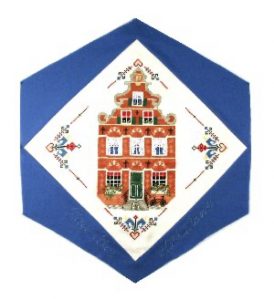Netherlands

The Block
The colourful, intricate piece was designed and beautifully embroidered by Greta LeCorney. The concept for the house theme came from Aleida Limbertie as the home is central to Dutch life. The balanced positioning of the open-work windows exemplifies the Dutch traits of precision and neatness. Behind the open windows, hand-made bobbin lace curtains, commonly used to decorate homes in Holland are visible. The ‘over curtains’ that are closed at night can be seen in others.
Against the house rests a bicycle, a popular form of transportation in Holland. In fact, there are more bicycles in the country that there are inhabitants. Shoes, miniatures of the wooden ones worn by farmers to keep their feet dry, are placed at the front door. The stylized floral designs framing the house display the bright colours the Dutch favour in their embroidery and in their gardens.
Cultural Profile
Located in Western Europe, The Netherlands (also known as Holland) is a small country whose name means ‘the Low Countries’ because approximately one quarter of its land mass is below sea level. It is made up of canals and windmills that once pumped water to dry out the soil, can still be widely seen. Dutch is the official national language, though West Frisian is also an official language in the north of the country. The major ethnic group is the Dutch, and Holland is one of the most densely populated countries in the world.
Dutch people value three things above all else: their children, their homes and their gardens. They have created a special kind of domestic life called gezellig, a home that feels cozy and enjoyable, where quiet evenings are treasured and family dinners are important. Saint Nicolaas is one of the Netherlands most beloved traditions. Celebrated on December 5th, the eve of the Saint’s day, gifts are given to friends and families. The name and the appearance of Saint Nicolas were adapted in North America by Dutch settlers in the New Amsterdam area (New York), eventually becoming the Santa Claus we know today.
Nearly 17% of Holland is made up of polders, large portions of land that have been reclaimed from the sea. This low-lying land makes the country sensitive to raising sea levels. Though small, the country is the second largest exporter of food and agricultural products in the world. Flowers are the best-known and largest crop. As a ‘thank you’ following Princess Margriet’s birth in 1943 in Ottawa where her hospital room was temporarily declared Dutch territory, Holland still sends 25,000 tulip bulbs to this Canadian capital every year for its Tulip Festival.
The Dutch love of flowers is also evident in the floral designs featured in many crafts, including embroidery, painted woodwork, and the popular blue and white Delftware porcelain. The city of Delft was at the center of the pottery industry in the Netherlands for many centuries, and porcelain is still being produced there.
The Netherlands, though very small, have left a durable imprint on Western culture. The country is renowned for its painters, such as Vermeer, Rembrandt, Steen, Van Gogh and Mondrian, architecture with notable modern architects such as Michel de Klerk and Piet Kramer, and philosophers Erasmus, Spinoza and Calvin Seervield. During the Age of Enlightenment, the country was a hot spot for freedom of speech. Many books which were censored in other European countries were printed and published here. That attitude of openness still endures today in the country.
Jan Smit is believed to have been the first Dutchman to arrive in Canada in 1680. In the late nineteenth century and post WWII, thousands of Dutch migrated here, settling in Ontario and the western provinces. There, their efforts in two main industries, farming and commerce, are clearly evident. The Dutch made significant contributions to the development of the Holland Marsh, one of the largest and most productive vegetable growing centres in Canada. They have created clubs and associations which provide cultural, educational, and social and sports activities for the Dutch community, but also enrich Canadian cultural life. As of 2011, there were over a million Canadians of Dutch ancestry living in Canada.
Sponsor: Netherlands Folklore Group
